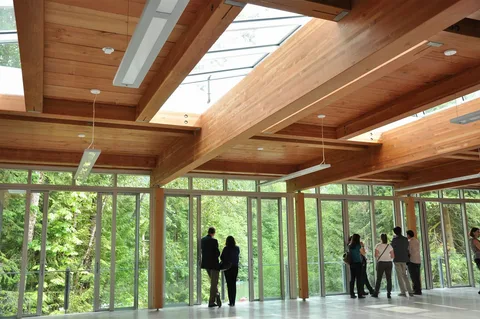In recent years, Cross-Laminated Timber (CLT) has gained significant attention as a revolutionary material in the world of construction. As we navigate the challenges of sustainability and climate change, CLT design is emerging as a game-changer that offers not only environmental benefits but also architectural and structural advantages. In this blog, we'll delve into the world of CLT design, exploring its composition, benefits, applications, and the future it holds in sustainable construction.
What is CLT?
Cross-Laminated Timber (CLT) is an engineered wood product made from layers of solid-sawn lumber boards stacked in alternating directions and bonded together with adhesives. This unique lamination process gives CLT exceptional strength, stability, and durability. It can be produced in various dimensions and thicknesses to suit specific construction needs.
The Benefits of CLT Design
Sustainability:
CLT is often hailed as a sustainable alternative to traditional building materials like concrete and steel. Wood is a renewable resource, and CLT production consumes less energy and generates fewer greenhouse gas emissions compared to other construction materials. It also acts as a carbon sink, sequestering carbon dioxide and helping combat climate change.
Rapid Construction:
CLT panels are prefabricated off-site, allowing for quicker on-site assembly. This reduces construction time, labor costs, and disruption to the surrounding environment.
Lightness and Strength:
Despite its lightweight nature, CLT is incredibly strong and sturdy. It can support heavy loads, making it suitable for a wide range of architectural designs and structural applications.
Design Flexibility:
CLT's versatility allows architects and designers to experiment with unique shapes and configurations. It can be used for walls, floors, roofs, and even entire buildings.
Applications of CLT Design
Residential Buildings:
CLT is commonly used in the construction of residential buildings, from single-family homes to multi-story apartment complexes. Its natural aesthetic also enhances interior spaces.
Commercial and Industrial Buildings:
CLT's strength and flexibility make it ideal for a variety of commercial and industrial applications, such as office buildings, warehouses, and factories.
Educational Facilities:
Educational institutions are increasingly turning to CLT for sustainable, aesthetically pleasing, and efficient building solutions.
Cultural and Recreational Spaces:
CLT's design flexibility allows for the creation of striking cultural and recreational venues, such as museums, theaters, and sports facilities.
The Future of CLT Design
The future of CLT design is undoubtedly promising. As the world continues to prioritize sustainability and eco-conscious building practices, CLT is poised to play a central role in shaping the construction industry. Here are a few trends and developments to watch for:
Tall Timber Buildings:
CLT is enabling the construction of tall timber buildings, challenging the dominance of concrete and steel in the high-rise sector. These structures showcase the strength and fire resistance of CLT.
Advanced Manufacturing Techniques:
Ongoing research is focused on improving CLT manufacturing processes, making them more efficient and cost-effective. This could further drive the adoption of CLT in construction.
Regulatory Support:
Governments and regulatory bodies are increasingly recognizing the benefits of CLT and are implementing policies and incentives to promote its use.
Sustainable Building Certifications:
CLT buildings are eligible for various sustainable building certifications, such as LEED and BREEAM, which can incentivize developers to choose CLT for their projects.
Conclusion
Cross-Laminated Timber design represents a significant advancement in the construction industry. Its sustainability, rapid construction, strength, and design flexibility make it a compelling choice for architects, builders, and developers. As we continue to seek environmentally friendly and efficient building solutions, CLT is set to lead the way toward a more sustainable and aesthetically pleasing future in construction. Keep an eye on this innovative material as it continues to redefine the way we build our world.


No comments yet